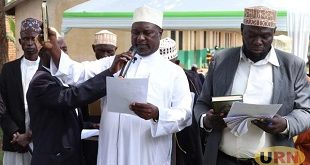
Luwero, Uganda | THE INDEPENDENT | Maize farmers in Luwero district are struggling to fight the resurgence of fall armyworms weeks after another pest left a trail of destruction in the gardens.
On March 26, the African armyworm was detected in Luwero at the farm belonging to Bugema University located in Kalagala sub-county. It spread fast to five sub-counties and two town councils destroying crops and pastures leaving farmers at a huge loss.
However, following the regular rains for the past two weeks, the African armyworms have died and their eggs washed away, disrupting their incubation.
But as farmers breathed a sigh of relief, another pest, the fall armyworm has re-emerged and caused destruction mainly to maize.
The fall armyworms have been reported in the sub-counties of Kikyusa, Luwero, and Luwero town council among others.
Margaret Nantume, a farmer in Kizito zone in Luwero town council says that the fall armyworms have destroyed her acre of maize plunging her family into food insecurity.
Joyce Muwanguzi, another farmer in Luwero town council says that after detecting the pest, she bought pesticides and attempted to spray against them but with no success.
Muwanguzi says that she has since abandoned her half-acre of maize after the fall armyworms destroyed it and now focuses on sweet potatoes.
Muwanguzi appealed to the government to donate free genuine pesticides to enable the kill the pest.
Wilberforce Ssemigga, the Luwero District Agriculture officer confirmed the resurgence of fall armyworms but said that they are manageable, unlike the African armyworms.
Ssemigga advised the farmers to spray against the pest in the early morning and late evening if they are to kill them.
He adds that the recommended pesticides by the Ministry of Agriculture are effective in killing both armyworms.
The fall armyworm was first reported in Luwero in 2017 feasting on maize plants, leaving devastation in the fields.
The pest can cause crop losses of up to 73 percent and once it is at an advanced larval development stage, can become difficult to control with pesticides.
*****
URN
 The Independent Uganda: You get the Truth we Pay the Price
The Independent Uganda: You get the Truth we Pay the Price



